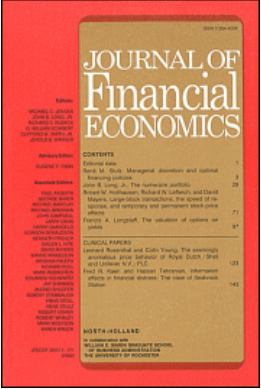The return of return dominance: Decomposing the cross-section of prices
IF 10.4
1区 经济学
Q1 BUSINESS, FINANCE
引用次数: 0
Abstract
What explains cross-sectional dispersion in stock valuation ratios? We find that 75% of dispersion in price–earnings ratios is reflected in differences in future returns, while only 25% is reflected in differences in future earnings growth. This holds at both the portfolio-level and the firm-level. We reconcile these conclusions with previous literature which has found a strong relation between prices and future profitability. Our results support models in which the cross-section of price–earnings ratios is driven mainly by discount rates or mispricing rather than future earnings growth. Evaluating six models of the value premium, we find that most models struggle to match our results; however, models with long-lived differences in risk exposure or gradual learning about parameters perform the best. The lack of earnings growth differences at long horizons provides new evidence in favor of long-run return predictability. We also show a similar dominance of predicted returns for explaining the dispersion in return surprises.
收益支配的收益:分解价格的横截面
如何解释股票估值比率的横截面分散?我们发现,市盈率差异的75%反映在未来收益的差异上,而只有25%反映在未来收益增长的差异上。这在投资组合层面和公司层面都成立。我们将这些结论与先前的文献相一致,这些文献发现价格与未来盈利能力之间存在很强的关系。我们的研究结果支持这样的模型,即市盈率的横截面主要由贴现率或错误定价驱动,而不是未来的盈利增长。评估了六个价值溢价模型,我们发现大多数模型都难以与我们的结果相匹配;然而,具有长期风险暴露差异或逐渐学习参数的模型表现最好。长期收益增长差异的缺失为支持长期回报可预测性提供了新的证据。我们还展示了预测收益的类似优势,以解释收益惊喜的分散。
本文章由计算机程序翻译,如有差异,请以英文原文为准。
求助全文
约1分钟内获得全文
求助全文
来源期刊

Journal of Financial Economics
Multiple-
CiteScore
15.80
自引率
4.50%
发文量
192
审稿时长
37 days
期刊介绍:
The Journal of Financial Economics provides a specialized forum for the publication of research in the area of financial economics and the theory of the firm, placing primary emphasis on the highest quality analytical, empirical, and clinical contributions in the following major areas: capital markets, financial institutions, corporate finance, corporate governance, and the economics of organizations.
 求助内容:
求助内容: 应助结果提醒方式:
应助结果提醒方式:


